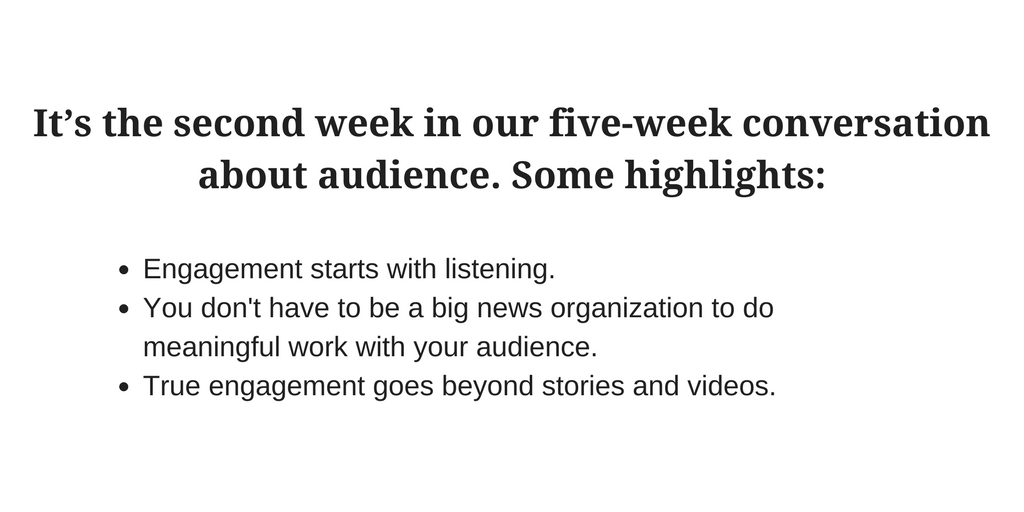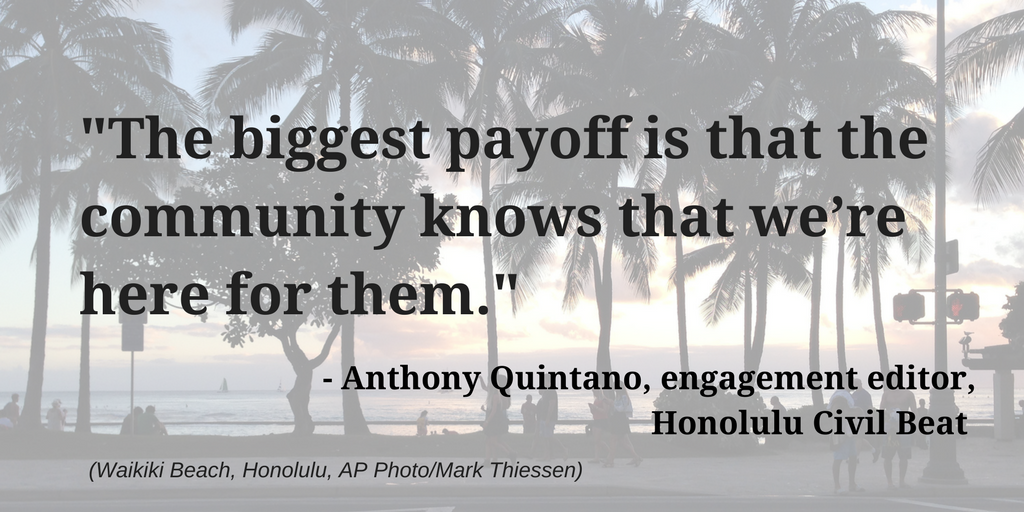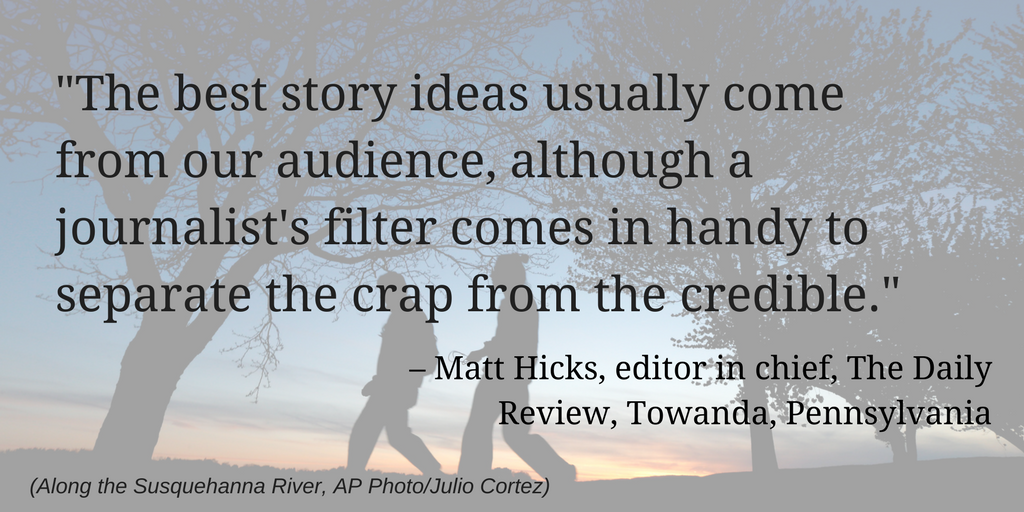This piece originally appeared in Local Edition, our newsletter following the digital transformation of local news. Want to be part of the conversation? You can sign up here.

In February, Honolulu Civil Beat started hosting weekly office hours on Facebook Live.
Civil Beat wanted to give its community a way into the newsroom each week to talk with journalists there, Engagement Editor Anthony Quintano told me.
The office hours have drawn an audience that shows up again and again, Anthony said. And they comment again and again about how grateful they are for the opportunity to talk with the newsroom.
“As if it was something so rare that they’ve never experienced it before,” he said.
Engagement and impact are primary goals at Civil Beat. The payoff in focusing on those goals?
“The biggest payoff is that the community knows that we’re here for them,” Anthony said. “A lot of times people feel ignored by their media outlets.”
Last week, I asked a question in this newsletter: Do journalists know best? Or do the best ideas come from the audience? Matt Hicks, editor in chief at The Daily Review in Towanda, Pennsylvania, said, basically, yes.
“The best story ideas usually come from our audience, although a journalist’s filter comes in handy to separate the crap from the credible,” he wrote in an email. “In the rural area we serve, our small staff can’t be at every meeting or ever-present in all of the communities we serve. Luckily, we have some good eyes on the street that keep us clued in to what we might miss while we’re busy with our beats and special sections.”
I reached out to a few other people at the forefront of audience and community engagement efforts to see what projects they admire. Here’s what they said:

Joy Mayer is an engagement consultant and part of the team behind Gather. I asked her to tell us more about that project.
“Gather is a place for people who work in engaged journalism to connect with and learn from each other,” she explained in an email. “Engagement has really grown up as a specialty, but too many people don’t feel like they’re part of the vast community of other practitioners. Instead, they feel unsupported as they forge an engagement path in their newsrooms. Gather will offer them case studies, guides, conversations, and relationships. I can’t wait.”
Me, neither! Here are some projects Joy’s excited about right now:
“Outlier Media is a fascinating nonprofit project in Detroit. Sarah Alvarez provides data-driven housing info to low-income residents. It’s such an interesting example of finding a group of people not usually targeted by journalists and discovering their very specific information need,” Joy said.
“The Austin Monitor hosts game nights (mentioned in this publisher column) to invite conscientious citizens to participate in solving a community problem. The game nights gamify things like the municipal budget.”
Joy said she’s also always on the lookout for examples of how newsrooms can support or create communities.
“The Washington Post’s Pay Up Slack community led to some cool stories,” she said. “And I hear was also a gold mine of support and resources for participants.”
Catherine Bouris, an Australian journalist, wrote “The Guardian in Australia is currently asking readers to submit stories about their neighborhoods following the release of the census.”
Kara Newhouse, a journalist in Falls Church, Virginia, recommended al.com’s Whitman, Alabama project. The documentary series travels around the state and into people’s lives as they recite from Walt Whitman’s “Song of Myself.”
What?! I know!
Here’s the introduction:
Kara also recommended WBEZ’s Curious City.
Hearken’s Julia Haslanger shared a handful of Hearken and non-Hearken projects, too:
KTOO’s Curious Juneau answers questions about local landmarks and history in Alaska.
Next Avenue, “where grown-ups keep growing” is gathering and answering questions on everything from learning a new instrument to how reverse mortgages work to how sex changes as you age, she said.
“NPR Goats & Soda, which is NPR’s global health and development blog, has an amazing series called #CuriousGoat that’s tackled famine, foreign aid, pandemics and more,” Julia said. “Sometimes they even adapt the stories for Snapchat, which I love.”
She also recommended some projects Hearken isn’t involved with.
“Jorge Caraballo used beautiful and smartly designed postcards to share information with residents of a neighborhood that was facing a lot of displacement and gentrification,” Julia said.
She recommends checking out how NPR’s Code Switch and journalist Gene Demby are using social media to both be transparent and engage with their audience.
“I’m eagerly watching how newsrooms like the St. Louis Post-Dispatch are using NextDoor,” Julia said. “I think there’s a lot of potential for NextDoor to be a valuable engagement tool in a newsroom’s toolbox, to see what a specific neighborhood is talking about, share resources during important moments, and maybe someday organize local events. But, it’s still early and only a few newsrooms are experimenting.”
If you didn’t see it last week, check out Unheard L.A. and Reckon, two projects rooted in local people and places. Also, Listening Post has projects in various cities that are worth checking out, as well as a new, free guide to creating a Listening Post where you live.
Jesse Hardman, who launched Listening Post NOLA, talked with me about all the different projects and the one thing they have in common.
“It’s starting with listening,” he said, “which I know sounds like a cliche, but I think it works.”

Thanks, everyone, for sharing these great projects!
Next week is boss week, and we’ll be talking with Phoenix Tso, editor at Alhambra Source in Alhambra, California. The hyperlocal site serves the multiethnic Los Angeles suburb.
In 2013, the site published a piece on how to engage Chinese immigrants that led the Alhambra Police Department to become the first in the country to get on Weibo, China’s version of Twitter.
In the meantime, subscribe to JTrust, a newsletter by Sara Catania that curates journalism that’s working toward rebuilding trust. Last week, I wrote about my visit to the Houston Chronicle and the ways that newspaper is sharpening how it approaches digital. (Also, there’s a barbecue podcast.) And save some time next month for this News University Webinar on how to build engagement using analytics.
See you next week!







